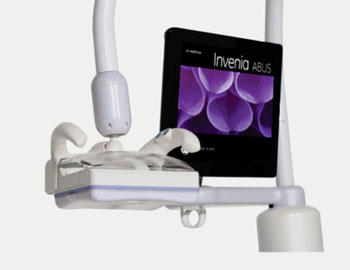Ultrasound Device Increases Breast Cancer Detection Sensitivity
By MedImaging International staff writers
Posted on 11 Oct 2015
A powerful new tool based on ultrasound (US) helps detect cancer that is mammographically occult in dense breast tissue. Posted on 11 Oct 2015
The Invenia Automated Breast Ultrasound System (ABUS) offers automatic volumetric US scanning, including image optimization for image review and analysis to aid in diagnosis of the entire breast tissue within just 15 minutes. The technology is based on the use of high-frequency reverse curve US transducer and advanced algorithms that automate the imaging process to help provide high image quality and reproducibility, including tissue equalization, nipple shadow compensation, and breast border and chest wall detection. A high-resolution touch-screen display helps to quickly and easily maneuver through the Invenia ABUS exam.

Image: The Invenia Automated Breast Ultrasound System (ABUS) system (Photo courtesy of GE Healthcare).
Images generated from the Invenia ABUS Scan Station are sent to the ABUS Workstation for interpretation, enabling fast, quick review and may also be archived to PACS or external storage to optimize breast US workflow. The 3D volumes are displayed in a patented, 2 mm thick coronal view slice from skin surface to the chest wall using proprietary pattern recognition software, resulting in rapid and intuitive analysis of intricate breast anatomy and pathology. The Invenia ABUS is a product of GE Healthcare (GE, Little Chalfont, United Kingdom).
“ABUS is valuable tool in the screening of women with dense breasts and therapy assessment,” said Brigitte Wilczek, MD, of Karolinska University Hospital (Huddinge, Sweden), who analyzed the effectiveness of combining an ABUS examination with a traditional mammography. “One patient who participated in the study was a woman in her late 60’s with more than 50% breast density. Her mammography screening results returned as normal, but the 3D-ABUS revealed a tumor in the upper-outer quadrant of her left breast.”
“Dense breast tissue makes it very difficult to detect pathological lesions when they are still very small. Thus many of the late diagnoses and the occurrence of interval cancers can be explained,” added László Tabar, MD, emeritus professor of radiology at the medical faculty of the University of Uppsala (Sweden). “With ABUS we can now offer our patients a screening method that can find cancers hidden in dense tissue as well as a mammography.”
Mammography may miss over 1/3 of cancers in dense breasts, which can also increase a woman’s risk to develop cancer by up to six times. Approximately 40% of women have dense breasts.
Related Links:
GE Healthcare
University of Uppsala










 Guided Devices.jpg)



